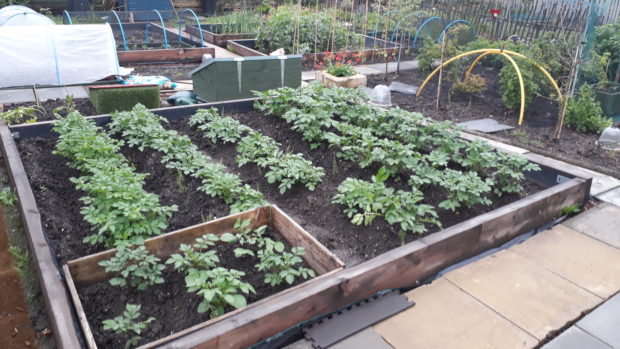I have never liked gardening.
Don’t get me wrong, I like gardens. I enjoy seeing a well-tended, flower-bedecked garden and I’ve spent many a happy hour in places like the National Trust for Scotland’s Inverewe Gardens. It’s just gardening I don’t like. Perhaps mainly because the gardens of most houses in which I’ve lived have been mainly lawn. And there’s nothing more boring than cutting grass.
So when my wife put down our names for an allotment some years ago, I wished her good luck as long as she didn’t expect me to be helping out. Such is the waiting list for allotments, that was over eight years ago. So it came as bit of a shock last autumn when we received an email telling us we were now top of the list. Were we still interested in taking it on? Let’s just say we are now the proud tenants of an allotment.
When I first saw it, I was rather taken aback, not just by the state it was in, but by its size: not so much an allotment, more a small croft. Indeed, it transpired that the previous two tenants had given it up to move to smaller plots.
Of course, it didn’t matter to me, as I wasn’t going to be doing any of the allotmenteering, I assured myself. However, with autumn morphing into winter, it was obvious that before any planting could be done, a considerable amount of weed-clearing and manual labour was going to be required. OK, I said, I’ll help with that aspect of the allotment.
Previous tenants had laid down carpets on paths and over the years these had matted into each other, clogged with weeds. As we cleared paths, in some places five or six layers of carpet had to be removed. Areas which had lain fallow for some time were weeded and dug over. Recycled slabs were laid and boundary fences rebuilt. We laid foundations and invested in a new shed – I liked that. Friends even donated a wee gas stove for cups of tea. Over the winter, raised beds were installed, and earlier this year we planted two areas of potatoes. Broad beans, French beans, peas, lettuce, garlic, leeks, onions, cabbage and beetroot all followed. Suddenly, I found I was hooked.
The previous tenant had left fruit bushes and a herb garden and these were retained with additional plants dug in. Last week, I picked our first strawberries and redcurrants. The blackcurrants look fine but are still a bit too wersh to be harvested.
Friends and neighbours have been supplied with the glut of broad beans we’ve grown. I’m now looking forward to the first of the potatoes being dug up in the next few weeks. In other words, I’m a total convert and don’t know how we ever survived without an allotment.
Like many similar sites across Scotland, and the rest of the UK, our plots were established during the First World War because of food shortages. At the start of hostilities, Britain was importing 70% of its cereals and 70% of its cheese, as well as all of its sugar. A German U-boat blockade began in early 1917. From February to May that year, nearly a million and a half tons of merchant shipping was sunk by submarines. At one point, Britain had just six weeks of wheat supplies and four days of sugar remaining. The Government empowered local authorities to take over land in parks and other unused areas for growing vegetables and fruit. Over 40,000 allotments were established in Scotland alone. Vegetable beds were created in the grounds of Buckingham Palace and Windsor Castle.
At the end of the Great War, there was a widespread and ultimately successful campaign to keep the allotments as they had proved so popular, and they again proved their worth during the Depression and in the Second World War. Today, they are a common sight in most of our cities and towns. In most places, there are long waiting lists for a plot. The wait on our site has now stretched to 10 years, such is the demand. People aren’t giving them up easily.
I’ve discovered there’s a broad mix of people involved in the allotment game, ranging from the unemployed to middle-class families, from teenagers to pensioners. But everyone supports each other with advice, something which is particularly helpful for newbies like us. And we’re now also hooked on TV gardening programmes. Last week, I heard Monty Don explain that groups of three or more apples in a tree should be reduced to allow better growth in the others. Who knew that? I was straight down to the plot to tackle the apple trees.
Today, we may not be facing the trials and dangers of a world war. But with Brexit looming, there are warnings of sharp increases in food prices and shortages of fresh produce – much of which we import. I’m still not a fan of gardening, but working an allotment is a different matter. Thanks to our new-found hobby, I can tell Boris, Jeremy, or even Nigel to do their worst – we will survive.
Campbell Gunn is a retired political editor who served as special adviser to two First Ministers of Scotland
